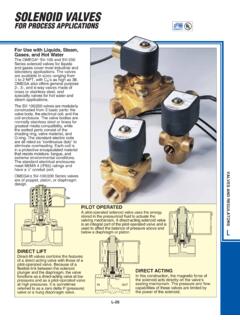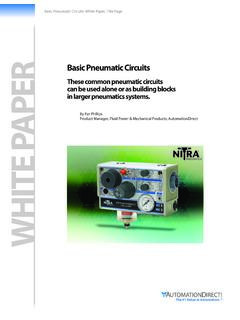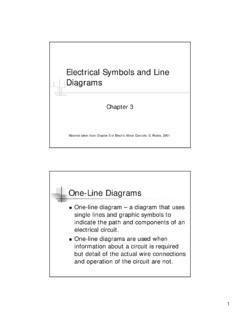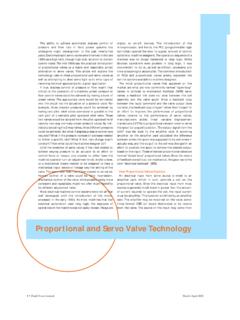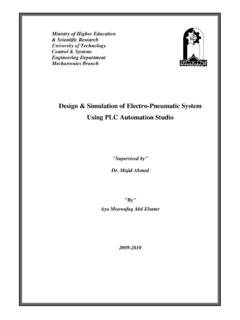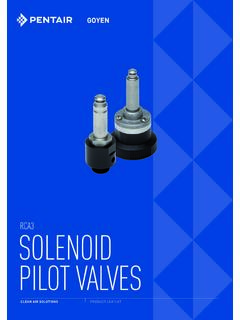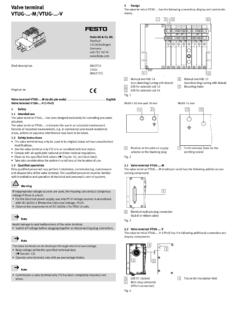Transcription of SIMPLIFIED VALVE CIRCUIT GUIDE - OMEGA
1 Z-20012 FLOW CONTROLMETERED-INFREE FLOWOUTCYLINDER EXTENDED IN OUT EXSOLENOIDVALVE NO. 21 2 3 10121 2 3 10121 1 3 3 2 2 10101212145 3112 SIMPLIFIED VALVE CIRCUIT GUIDEA GUIDE TO UNDERSTANDING PNEUMATICDIRECTIONAL CONTROL VALVESZ-201 Compressed Air ValvesDirectional control valves start, stop or change the direction of flow in compressed air manufacturing companies apply compressed air as the power to operate tools and equipmentwhich are used to make the products they offer. To understand the different applications ofcompressed air and how valves are used, one must first have a knowledge of the kinds and types ofvalves used by are designed for different applications and a factory may use several different types of valveswith each being suited for a particular job. These designs fall into the following categories: spool bonded and lapped; poppet; a combination of spool and poppet; sliding seal; rotary and two types of spool (bonded and lapped) and the poppet are the most common designs in use.
2 Of these, Norgren makes valves using the packed and bonded spools and the poppet spool valves use an elastomer to seal against pressure. Bonded spools allow practically noleakage, can be used in three-position applications, and the standard VALVE goes through a blockedcenter, which prevents blowby from the exhaust ports when changing from one flow pattern Spool valves are tolerant of dirt and compressor varnish and when lubricated properly, will cycle for millions of valves use a large poppet seal and operate much the same way as a home water faucet. The seal surface moves perpendicular to the VALVE area and pushes against an annular ridge forpositive sealing. Poppet valves are fast, rugged, and known for their ability to operate under adverse valves are available in 3-way and 4-way configurations. A 3-way spool VALVE can be used as a 2-way VALVE by blocking one port.
3 Poppet valves are made in 2-way, 3-way, and 4-way configurations. VALVE OperationTwo Way ValvesTwo-way valves turn air on and off in applications such as shop air, branch airlines, supply pressure to systems, and supply air to tools, motors and similar equipment. Two-way valves can also be used as vent VALVE , 2-Way, 2-PortNormally closed 2-way valves block inlet flow when in the unactuated position. Inlet flow is passing when : VALVE symbols always show the unactuated position in the lower 2-WAYSYMBOLACTUATEDPOSITIONUNACTUATED POSITIONINOUTC ompressed Air Valves, open2-way valves pass inlet flow when unactuated and block flow when open valves can be applied to safety applications which require cooling flow, actuated. Normally held off cooling flow would come on in event of ReturnAdded to VALVE symbol. The spring returns the VALVE to its normal, unactuated OperatorSimplified air operator added to the VALVE symbol.
4 When the VALVE is actuated, the flow pathshown in the upper block replaces the flow path in the lower VALVE , 3-Way, 3-Port, Used as a 2-Way, 2-PortTo use a 3-way spool VALVE as a 2-way normally closed VALVE , plug port 3 and connect theinlet to port 1 and the outlet to port 2 Spool VALVE , 3-Way, 3-Port, Used as a 2-Way, 2-PortExcept:The normally open, 2-way configuration is not possible with the 3-way 1 8" Nuggetsolenoid operated VALVE . This VALVE does not have provisions for "Normally Open" solenoidoperated 2-WAYSYMBOLACTUATEDPOSITIONUNACTUATED POSITIONINOUT3-WAYUSED AS 32 OUTIN 112103-WAYUSED AS 12 OUT31210 SPRING RETURN 2-WAYSYMBOLINOUTSIMPLIFIEDAIR PILOTSYMBOLZ-202Z-203 Poppet and Spool Valves, 3-Way, 3-PortNormally Closed 3-Way Valves When unactuated, block inlet flow and connect the outlet port to the exhaust port. When actuated, the inlet port is connected to the outlet port and the exhaust port is Open 3-Way Valves When unactuated, pass inlet flow to the outlet and block the exhaust port.
5 When actuated, inlet flow is blocked and the outlet port is connected to the exhaust :The normally open configuration is not possible with the 3-way 1 8" Nugget solenoid operatedvalve. This VALVE does not have provisions for an external pilot supply which is required for "NormallyOpen" solenoid operated valves. Three-way VALVE applied to a spring return ValvesThree-way valves are the same as 2-way valves with the addition of a third port for exhaustingdownstream air. Three-way valves are available in a normally open or normally closed operatingconfigurations. These valves are used to control single acting or spring return cylinders and anyload which must be pressurized and alternately exhausted. These valves can also pilot other airoperated 3-WAYSYMBOL IN2 3-WAYUNACTUATED1 IN2 OUT3 EXSPRING RETURNED RETURNED 3-WAYACTUATED1 IN2 OUT3 EXCYLINDER 3-WAYSYMBOLIN2 OUTEXZ-204 Three-Way Valves, valves can be used as a remote air pilot for larger mounted 3-way control valvePower Valve2 OUT3 EX1 IN2 OUT3 EXCOOLING AIR1 3-way Actuated(Cooling air held off)Note:A normally open 2-way poppet VALVE can alsobe used in place of the normally open 3-way 3-way unactuated(Upon loss of pilot signal, VALVE supplies cooling air.)
6 1 IN2 OUT3 EXINEXCYL. 1 CYL. 2 Four-Way ValvesFour-way valves use two 3-way VALVE functions operated at the same time, one normally closed andone normally open. These valves have two outlet ports that alternate between being pressurized andexhausted. Four-way valves are used to operate double acting air cylinders, control bi-directional airmotors and in air circuitry. Also two single acting cylinders can be operated with one 4-way Valves, 4-Way, 4-PortThe flow paths for an unactuated VALVE are inlet to cylinder 2 and cylinder 1 to exhaust. Whenactuated, the inlet is connected to cylinder 1 and cylinder 2 is connected to exhaust. Four-waypoppet valves have one exhaust port which is shared by all cylinder 1 CYL. 2 INThree-way VALVE applied to a cooling air supplyZ-205 Spool Valves, 4-Way, 5-PortThe 4-way spool VALVE can be controlled by using two operators, one on each end or by a spring returnand a single operator.
7 The flow path when actuated at the 14 end of the VALVE is from port 1 to port 4and from port 2 to port 3. Port 5 is blocked. When the VALVE is actuated from the 1 2 end, the flow pathis from port 1 to port 2 and from port 4 to port 5. Port 3 is blocked. Each cylinder port has a separateexhaust 1 CYL. 2 CYLINDER RETRACTED4-WAYUNACTUATEDNINEXCYL. 1 CYL. 2 CYLINDER EXTENDED4-WAYACTUATED14EX 5EX 3IN2 OUT4 OUT1211214 CYLINDER EXTENDED4-WAYACTUATED4123 Cylinder Speed ControlCylinder speed control requirements are defined by the load being moved or work done on control on cylinder extension stroke, metered exhaust air-metered out. Speed control on cylinder extension metered out (Poppet valves)Install the flow control device at the rod end of the cylinder with the free flow arrow toward thecylinder. When the VALVE is actuated, pressure is applied to the blank end of the cylinder.
8 Air beingexhausted from the rod end cannot go through the check VALVE and must flow through the needlevalve of the flow control before being exhausted by the VALVE . The cylinder is being extended againsta cushion of air that is slowly being bled to 1 CYL. 2 METERED FLOW4-WAYACTUATEDFLOW CONTROLMETERED-OUTINT hree-way valvue applied to a spring return cylinder214 CYLINDER RETRACTED4-WAYUNACTUATED41235 EXCYL. 1 CYL. 24-WAYUNACTUATEDFLOW CONTROLMETERED-OUTINA 4-way Poppet VALVE applied to a double acting air cylinderFour-Way Valves, 1 CYL. 24-WAYUNACTUATEDFLOW CONTROLMETERED-INFREE FLOWINEXCYL. 1 CYL. 24-WAYUNACTUATEDFLOW CONTROLMETERED-OUTS peed Control on Cylinder Extension Metered-InInstall the flow control at the blank end of the cylinder with the free flow arrow away from the cylinder. When the VALVE is actuated, the rod end of the cylinder isexhausted and pressure is metered-in at the blank end.
9 Cylinder speed dependson the load or work done on extension. Although not as stable as metered-out, this method is used in circuits using sequence valves and pressure switches. Speed Control on Cylinder Extension and Retraction Metered-OutInstall a flow control at each end of the cylinder with the free flow arrow toward the cylinder. When thecylinder is extended or retracted, it will be doing so against a cushion of air being slowly bled to theatmosphere. Extension and retraction speed can be controlled by adjusting the flow control needle using flow controls, they should be mounted in the cylinder ports or as close to the cylinder aspossible. Flow controls MUST be mounted between the cylinder and the VALVE when using a poppetvalve, except for the multi-directional 3-way selector VALVE (C1012/48).Flow Controls When Used with Spool ValvesWhen flow controls are used with spool valves, the connections and location can be the same as when used with poppet alternate method of cylinder speed control is to use a needlevalve in one or both exhaust ports of the spool VALVE .
10 This methodeliminates the need for a check VALVE in each flow RETRACTED4-WAYUNACTUATED41235 FLOW CONTROLMETERED-OUT214 CYLINDER RETRACTED4-WAYUNACTUATED41235 NEEDLE VALVES1Z-206 Four-Way Valves, ApplicationsAir-Spring Returned Cylinder (Spool VALVE Shown)A double acting cylinder can be extended using a manual, push-pull 3-way VALVE and retracted with aconstant bias air pressure. The regulator supplying the bias pressure must be a relieving type and canbe set at 10 to 20% of the pressure being applied to the blank end of the cylinder. This CIRCUIT can beused with clamping fixtures and anywhere a cylinder can be retracted at a low Exhaust (Spool VALVE Shown)The air exhausted from cylinder retraction can be used to do secondary work such as operating avibrator or to clean or eject Shot Output (Spool Valves Shown)The one shot CIRCUIT is used to shorten long signals which may still be actuating a VALVE when it isnecessary to reset the same VALVE .
